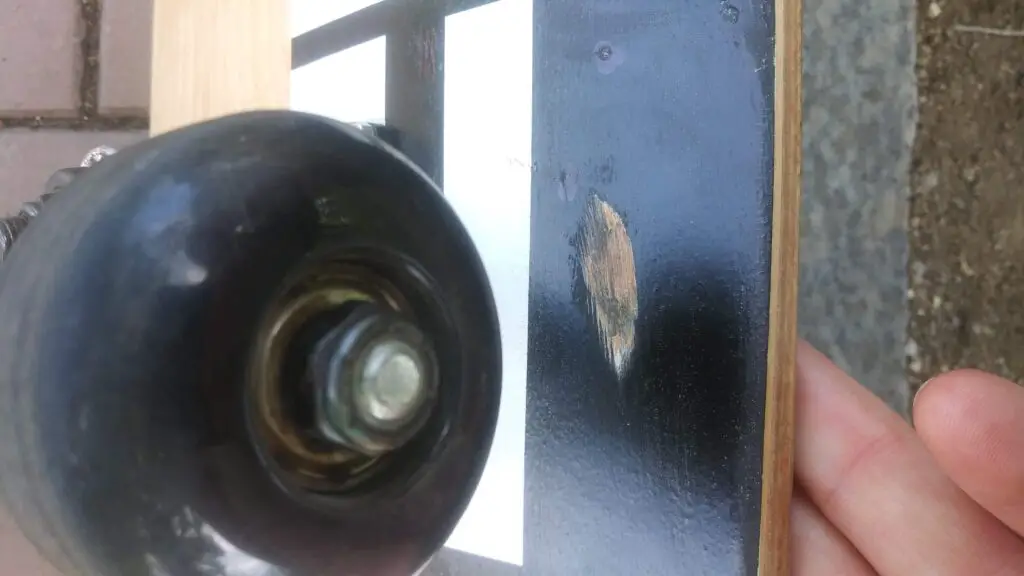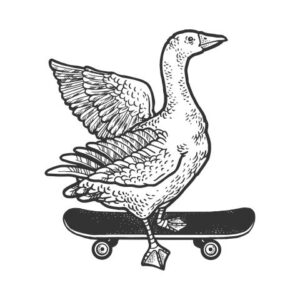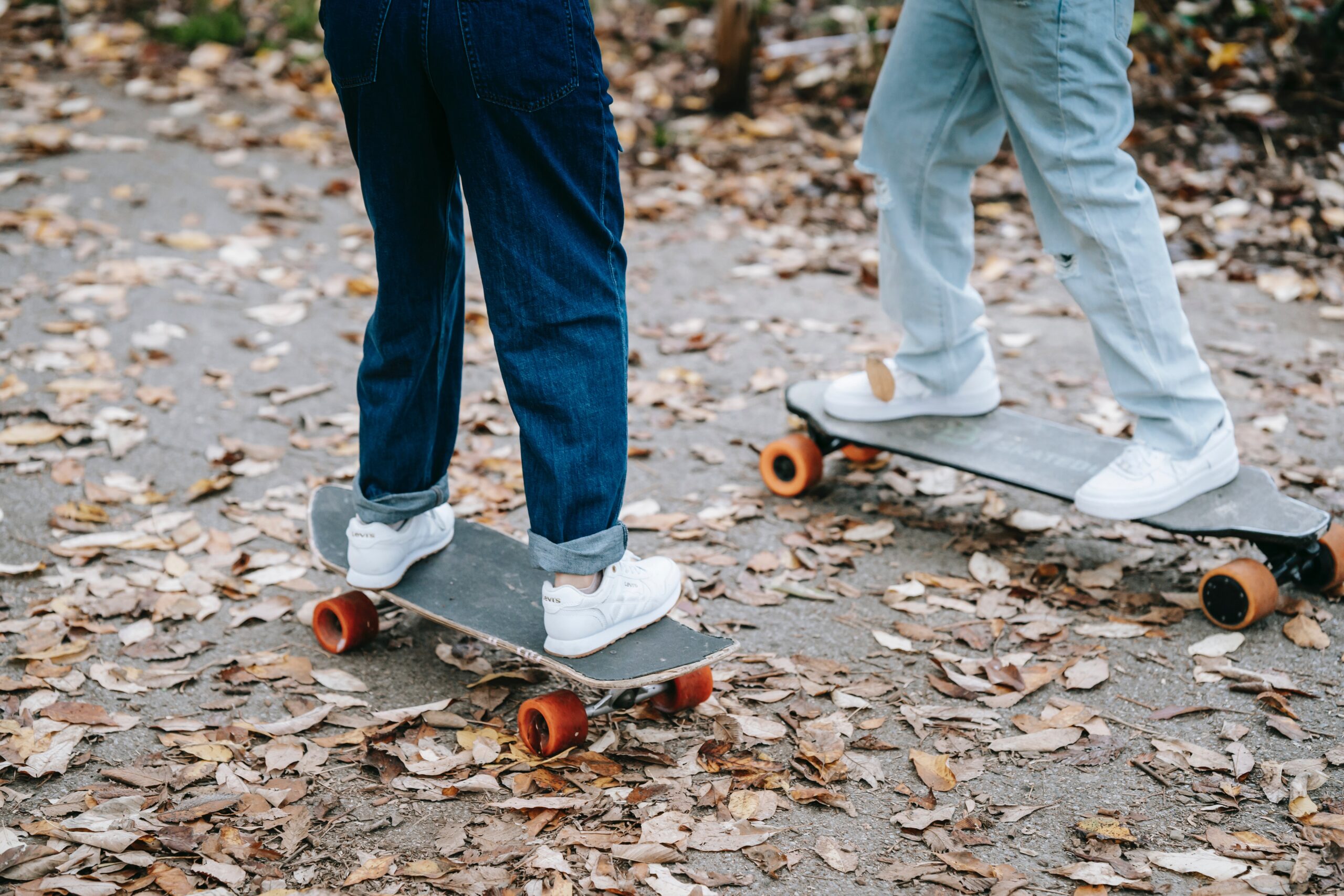Cruising is one of the greatest joys of skateboarding. I love putting in earphones and just pushing along the sidewalks to somewhere I’ve never been before.
Luckily, you don’t need a longboard or a cruiser board to cruise your city. A skateboard can be just fine to use as a cruiser if you replace the hard and small skateboard wheels with softer and larger longboard wheels and add riser pads to your board. After this, you’re good to go.
Can you Cruise on Skateboard?
I currently cruise on a skateboard set up with longboard wheels and riser pads. I prefer this to longboards and cruiser boards because you can still make tight turns and also ollie. Being able to ollie while cruising is nice to hop up on ledges and jump over speed bumps.
It’s just more fun.
Skateboards can be used to cruise on smooth pavement with no changes. However, generally, you will need to replace the skateboard wheel with cruiser wheels and add riser pads to your set-up. The riser pads help avoid wheel bite and the larger wheels make for a much more comfortable and smoother ride.
Also, converting a skateboard into a cruiser board can be cheaper than buying a cruiser or longboard outright. I recommend taking an old beat-up skateboard you already have and replacing the wheels and adding riser pads. Unfortunately, these additions will still cost you around $60-$90 in total.
How to Cruise on a Skateboard
Put Longboard Wheels on Your Skateboard
While you might think your skateboard wheels are perfect for cruising along, you are wrong. If you don’t believe me go and try it. When you come across pavement that isn’t so smooth you will be shaking and pushing every 5 feet. This is not enjoyable.
So you really need to put longboard wheels on your skateboard.
How Much Do Longboard Wheels Cost?
The price ranges widely for longboard wheels.
Longboard wheels cost on average between $25-$70. The quality you get varies quite a lot in this price range. Expect to spend at least $30-$40 for a set of quality wheels. Longboard wheels are available at the cheapest prices on Amazon.
You can find a quality pair of wheels through amazon. I recommend getting a smaller size like 70mm to avoid wheel bite. You don’t want your board looking like a monster truck.
How Do I Put Longboard Wheels on My Skateboard?
Putting longboard wheels on your skateboard is really the same as putting normal wheels on it. You will need a skate tool or the correct-sized wrench set. Or alternatively, any skate shop would help you put your wheels on.
Simply remove the exterior bolt with your skate tool by unscrewing it counter-clockwise. The wheel will come off and you will see the truck and bearings inside your skateboard wheel. Remove the bearings and push them inside your new longboard wheels. Fit the wheel back onto the truck and reattach the exterior bolt by screwing it clockwise until tight.
This can be a bit tricky with the wheel bearings so it might be best to follow a guide like the one here.
Put a Riser Pad on Your Skateboard
Riser pads might not seem like a necessity, but they are as they prevent wheel bite. No, wheel bite does not mean hitting a small pebble and falling. It refers to when the board touches your wheel when turning or carving. This contact messes up your skating and causes cracks in your deck. This will cause your deck to break sooner.
Normally, you would just tighten your trucks to avoid wheel bite, but not with longboard wheels on a skateboard. The trucks aren’t designed for a wheel that large. So we need to add riser pads.
What Are Riser Pads?
There isn’t too much to say about riser pads.
Riser pads are cheap plastic parts that fit between your deck and trucks. They are designed to increase the distance between your deck and board to allow for a larger wheel and provide a smoother ride. The riser pad also acts as a cushion that creates a more comfortable riding experience.
They just do two things; provide cushioning and create distance between your deck and trucks.
How Much Does a Skateboard Riser Pad Cost?
Riser pads are cheap.
Riser pads cost between $5-$15. These are very cheap plastic parts that you fit between your trucks and your board to give more space for the larger longboard wheel. Call ahead to your local skate shop to see if they have any riser pads in stock or you can order them from Amazon. If you purchase them from a skate shop, they will help you put them on your board.
If you put longboard wheels on your skateboard, you need a riser pad or you get wheel bite. This is a no-no.
What is Wheel Bite?
Before you tighten the trucks on a new complete set-up, you might have noticed that the wheels make contact with the board when you turn. This causes you to stop abruptly and fall. Wheel bite makes a board pretty unskateable.
Wheel bite refers to the wheels on your skateboard or longboard making contact and rubbing against the board itself. This typically occurs when you are turning, or carving, your skateboard as the board itself tilts in towards the wheel. Wheel bite can cause significant damage to your board and cause premature fracture of the board.
So yeah. Wheel bite sucks. You need riser pads so it doesn’t happen. Luckily riser pads are quite cheap.

How to Push on a Cruiser Skateboard
Pushing is natural for most people. The most important thing is to focus on foot position. Position your front non-dominant foot towards the front of your board so that your heel is just behind the front bolts. I keep my front foot at a 45-degree angle with the board as I push off. Once I stop pushing, my back foot comes onto the board and my front foot moves to be perpendicular with the board.
While riding, it is best to have your front foot perpendicular to the board as it gives the greatest control and allows for the easiest turns. See in the gif below that I turn my front foot once my back foot comes onto the board.
How to Stop on a Cruiser Skateboard
Stopping while cruising is best done by lightly dragging your foot along the ground until you come to a complete stop. This method can also be used to slow down. Don’t put your entire weight on your foot, but rather let it drag with most of your weight still on the board itself.
First practice by having one foot hang off of the board without touching the ground.
Once you can do this comfortably, try dragging your foot along the ground. It will take some practice, but be patient. This move is critical to being able to control your speed as well as stop. You need this before you take to cruising in the streets or along the sidewalks.
How to Turn on a Cruiser Skateboard
Turning on a cruiser skateboard is the same as on a regular skateboard or longboard. Simple shift your weight in the direction that you want to turn so that you are leaning in that direction. Once you’ve completed your turn shift your weight back over the center of the board.
This can take a bit of practice but is intuitive for most people. If you are turning when you don’t want to, then you need to make sure your feet and weight is centered on your board above the bolts.
Where to Cruise on a Skateboard
Really you can cruise anywhere where pavement or concrete exists and you have enough space to turn. However, some places are better than others when it comes to navigating your city and cruising along.
Parks
Parks typically have smooth pavement and scenic paths to cruise along. If I come across a park on my skateboard, I almost always make a point to cruise through it. The only issue here is that parks are usually pretty small and you need lots of space to cruise. You could easily cruise through the entirety of most parks in 5 minutes.
Still, starting off a cruise session in a park is a great and relaxing thing to do. The only thing is sometimes a park can be crowded which will mean lots of starting and stopping. Otherwise, I love parks. Go cruise there.
Sidewalks
Sidewalks are the safest bet for a good longboarding experience. You can’t be in the crowded part of town, but sidewalks are safe and connect everywhere. You can cruise throughout the entire city using sidewalks with no issue typically even if they’re a bit rough.
Usually, I stick to the sidewalks or bike paths when I cruise my city. If it’s too crowded though sometimes I need to hop off of my board and walk until the sidewalk clears up a bit.
Regardless, I recommend sidewalks. They are cool and let you cruise everywhere. Go cruise them.

Streets
Streets are almost perfect for cruising as they are wide, open, and typically smooth. There are no bumps other than an occasional speed bump and they’re usually clean. There is just one issue: Cars.
And buses and motorcycles too. The issue really is that you can’t control the people driving the cars and buses and motorcycles and a collision could be fatal. You have no protection as a skateboard. An accident with a car will be bad and potentially deadly for you.
Even if you take caution and only cruise in bike paths and follow traffic lights, the risk is still there. Drivers can be erratic and unpredictable. Someone might be drunk behind the wheel or someone might be extremely tired. Sometimes drivers don’t even register seeing a skateboarder as it’s such an uncommon sight.
The only recommendation I can give is to avoid streets with heavy traffic and wear a helmet always.
Otherwise, get after it. Cruising in the streets is way more fun than cruising along a sidewalk generally. It just feels more rebellious and more “right”.
Do I Need to Wear a Helmet While Cruising?
Cruising is safer than doing tricks on a skateboard, but helmets are still sometimes necessary.
If you are cruising in the street or are a beginner then you need to wear a helmet. An accident with any vehicle can be fatal and drivers can be unpredictable. Beginners need protection as they become comfortable riding a skateboard. Generally, wearing a helmet is never a bad idea.
So don’t worry about looking cool and just wear the helmet. If you’re only cruising sidewalks and parks then you won’t really need a helmet if you’re comfortable on your board. I can’t remember the last time I fell off of my longboard.
Skateboard Cruising Tips
Conclusion
Cruising on a skateboard is one of my favorite things about skating. Honestly, it is enjoyable enough that it’s all that some people do. You can get outside, listen to your favorite music, and explore your city or town.
Skateboards really aren’t ideal for cruising unless you change the wheels and add riser pads. Adding these to your skateboard can be cheaper than outright buying a longboard or cruiser board.
Start by cruising in parks and along sidewalks. If you cruise in the street always wear a helmet!
Anyway, thanks for reading and look out for more content from Board and Wheels.





